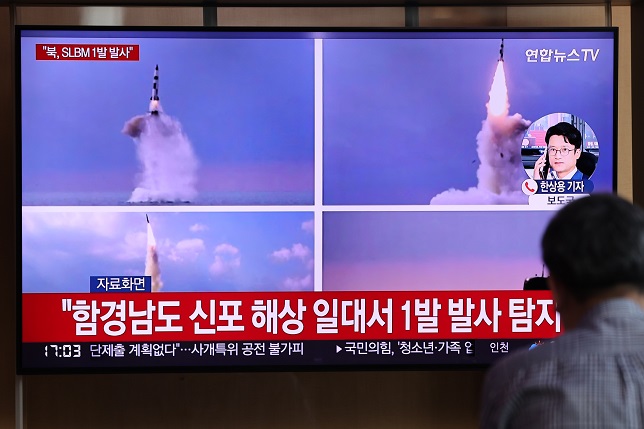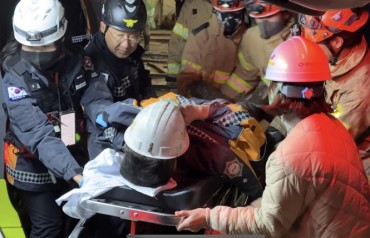
n this file photo, a news report on North Korea’s short-range ballistic missile launch is aired on a TV screen at Seoul Station in Seoul on May 7, 2022. (Yonhap)
SEOUL, June 5 (Korea Bizwire) — North Korea fired eight short-range ballistic missiles (SRBMs) toward the East Sea on Sunday, a day after South Korea and the United States wrapped up their joint drills near the peninsula involving a U.S. aircraft carrier, according to the South’s military.
The Joint Chiefs of Staff (JCS) said the launches were detected between 9:08 a.m. and 9:43 a.m. from areas around Sunan in Pyongyang; Kaechon, north of the capital city; the northwestern region of Tongchang-ri; and the eastern city of Hamhung.
The missiles flew around 110-670 kilometers at altitudes of 25-90 km with speeds of Mach 3 to 6, it added.
The intelligence authorities of South Korea and the U.S. are conducting an analysis for more details, it said.
An informed source said two missiles were shot from each site “sporadically,” presumably from transporter erector launchers (TELs), the largest number of ballistic missiles the North has recently launched “on a single day and occasion.”
“The North’s continued launch of ballistic missiles are provocations which poses a significant threat to peace and security not only on the Korean Peninsula but also in the world,” the JCS said in a statement.
Soon after the launch, JCS Chairman Gen. Won In-choul and Gen. Paul LaCamera, top commander of the South Korea-U.S. Combined Forces Command, held video talks and reaffirmed the allies’ capabilities and defense posture to immediately track and intercept North Korean missiles, according to the JCS.
It was the North’s 18th show of force this year and the third since President Yoon Suk-yeol took office May 10 with a pledge to get tough on the recalcitrant regime.
The North test-fired a suspected new-type intercontinental ballistic missile and two apparent SRBMs into the East Sea on May 25 right after U.S. President Joe Biden’s trip to Seoul and Tokyo.
South Korean and U.S. government officials said Pyongyang seems to have completed preparations for another nuclear test.

This photo released by the Joint Chiefs of Staff (JCS) on June 4, 2022, shows South Korean and U.S. naval ships making a formation during a three-day combined exercise in international waters off Okinawa.
The previous day, South Korea and the United States finished a three-day combined exercise in international waters off Okinawa mobilizing the USS Ronald Reagan, a nuclear-powered aircraft carrier, apparently in order to send a stern message against North Korea’s continued missile provocations.
It marked the first time for the allies to have mobilized a nuclear-powered aircraft carrier during a combined exercise since November 2017. North Korea has been highly sensitive to such a joint military exercise by the allies, describing it as a rehearsal for invasion.
The U.S. Indo-Pacific Command said Sunday’s missile launches highlight the “destabilizing impact of the DPRK’s illicit weapons program.” DPRK stands for the North’s official name, Democratic People’s Republic of Korea.
“We are aware of the DPRK’s multiple ballistic missile launches and are consulting closely with our allies and partners,” it said in a press release. “The U.S. commitment to the defense of the Republic of Korea and Japan remains ironclad.”
The South’s presidential office convened an emergency National Security Council in response to the North’s latest missile testing. It strongly condemned the North in a statement issued after the session presided over by National Security Adviser Kim Sung-han.
(Yonhap)






